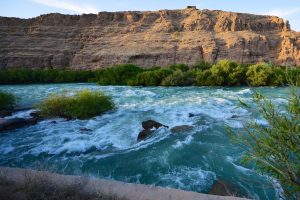Iranian border guards and Taliban fighters opened fire on one another, killing three, near a border post between Iran and Afghanistan in southwestern Nimroz province on May 27. Although it is unclear what led to the incident, relations between the two countries have soured in recent months over conflicting claims to the water of the Helmand River.
The firing incident notwithstanding, there is a limit to how far each side would allow their relations to worsen. Both Tehran and Kabul need one another and eventually will find a way to manage their conflicting claims.
The river in question, the Helmand River, flows from the Hindu Kush mountain range across Afghanistan before it branches near the Afghan-Iranian border. There it splits into the Shele Charak River, which forms the border between the two countries, and the Sistan River, which flows westward into Iran.
Iran has accused Afghanistan’s Taliban rulers of violating a 1973 treaty by restricting the flow of water from the river to Iran’s parched eastern regions. The Taliban deny the accusation and claim that the Helmand River does not have much water. In response, Iranian President Ebrahim Raisi and Minister of Interior Ahmad Wahidi have proposed a field visit by technical officials to ascertain the ground situation. “If there is no water, the issue will be resolved,” Wahidi has said. In May, Raisi warned the Taliban about disregarding Iran’s water rights. In response, a former Taliban official mocked Raisi in a video that went viral.
There is a long history to the dispute over the Helmand’s water, and the 1973 treaty has not done much to resolve it. While the treaty ensures that Iran has access to the river, it gives Afghanistan complete ownership of the rest of the water supply. The treaty distinguishes between a “water year” and “normal water year” and says that during a normal water year, Afghanistan must deliver water to Iran at a rate of 22 cubic meters per second per annum with an additional four cubic meters per second, thereby supplying an annual average of 820 million cubic meters under normal conditions. While the treaty ensures Iran’s access to water, it gives Afghanistan absolute unilateral rights over the water supply of the river. Thus, each of the countries can cite the treaty at their own convenience. Most importantly, since the treaty has not been ratified by Afghanistan, Kabul isn’t obliged to abide by it.
Over the decades, Afghanistan’s rulers have used the advantage of being an upper riparian state to extract (or at least try to extract) benefits from Tehran in return for water. However, the issue of conflicting claims over water also stems from Iran’s over-dependence on the Helmand’s water and its absolute mismanagement of water resources in the country.
In August 2002, then-Afghan President Hamid Karzai failed to honor an agreement settled with Iranian President Mohammad Khatami, during the latter’s visit to Kabul, to supply 1,000 hours of water supply to Iran. After 240 hours, taps were turned off, according to Iranian media. In March 2021, then-Afghan President Ashraf Ghani inaugurated the Kamal Khan Dam in Nimroz province and asked Iran to provide fuel to Afghans in return for water.
After taking power, the Taliban changed Ghani’s policy. In January 2022, the Taliban regime released water from the Kamal Khan Dam into Hamun Lake in southeastern Iran, which is a poor and arid region. Iran thanked the Taliban in return. However, the decision was criticized by some Afghans, who demanded that the water should be given to Afghan farmers. Following this, the Taliban’s Water and Energy Ministry denied that water had been released into Iran.
The Taliban appear to have realized that currying favor with Tehran, which is a major trade partner, cannot come at the cost of annoying Afghans, among whom the regime is seeking to boost its popularity. A balance needs to be maintained in which neither group is alienated. That, however, is a delicate balance to be made, given the fact that the Iranian regime itself has used the water issue to hype nationalism at home and hide the fact of its over-dependence on the Helmand River and chronic domestic water mismanagement.
Words of reconciliation have already been heard from the Taliban side. The Taliban prime minister’s political commission met on May 28 and endorsed the 1973 water treaty agreement, calling it the “best solution.” Members of the commission called for good relations with neighboring countries, particularly Iran.
The Taliban need Iran. It’s a country with which they can trade and seek favors, especially important when the Taliban’s objective of gaining recognition and legitimacy from the world community has met a dead end. While water is one of the few areas of contestation between the two countries, bilateral relations between them have progressed well in the past year.
Iran, on the other hand, may try to pressure the Taliban to share more water, but it is not likely to cross the line and try to destabilize the regime. A range of mutual interests, therefore, would continue to bind these two countries together and could push them to find at least an ad-hoc way to manage water sharing.
































